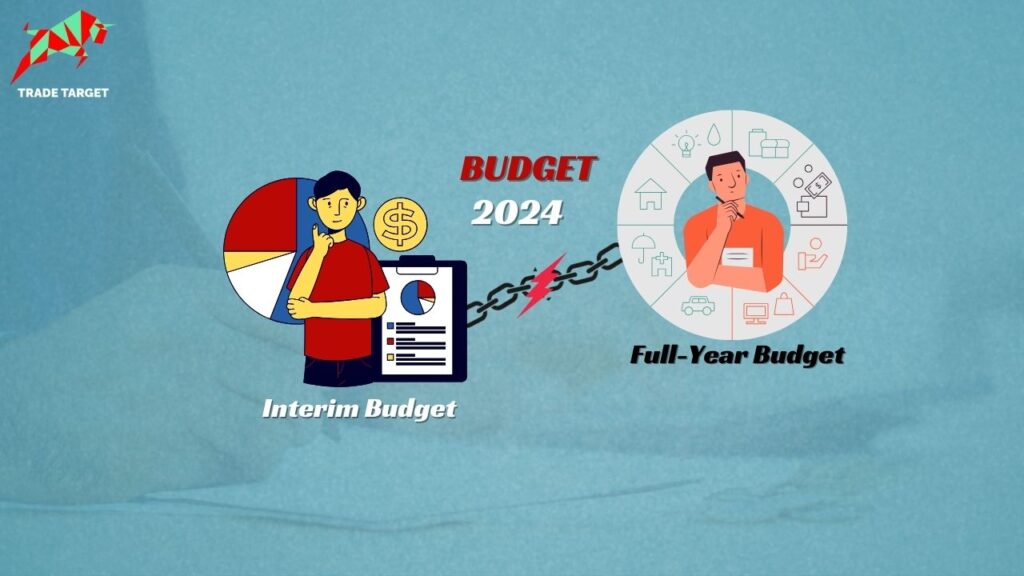India’s economy is standing out amidst a global economic slowdown. Projections for India’s economic growth in FY24 range from 6.3% (by the IMF and World Bank) to 6.5% (by the RBI). In contrast, as per the IMF, global growth is expected to decrease from 3.5% in 2022 to 3% in 2023 and 2.9% in 2024.
Also Read This: What is fiscal deficit? Can India Reach the 5.9% GDP Target?
Finance Minister Nirmala Sitharaman is set to announce the interim budget for 2024-25 on February 1, 2024. This interim budget comes before the upcoming general elections, and the full budget will be presented once the new government is in place.
This will be her sixth budget presentation. In India’s fiscal management, the terms “Interim Budget” and “Full-Year Budget” play crucial roles, each serving specific purposes and timelines in the nation’s economic cycle.
In the world of government finance, the term “interim budget” often surfaces during times of political transitions or impending elections.
Let’s understand the difference between an Interim Budget and a full-year Budget.
What is an interim budget?
An interim budget is like a temporary financial plan the government puts in place when elections are around the corner or when a new government is about to take charge. It’s a quick arrangement to handle the government’s spending needs quickly until a new government can create a complete budget.
Key Aspects of an Interim Budget
- Expenditure Allocations
An interim budget focuses on allocating funds for essential government operations, ongoing projects, and urgent requirements. Unlike a full-year budget, it avoids introducing new policies or schemes with financial implications.
- Policy Limitations
Because it’s temporary, an interim budget doesn’t make long-term policy changes or reforms. Instead, it aims to keep stability and continuity in governance until a new government takes over.
- Approval Process
In contrast to a full-year budget, an interim budget doesn’t go through the usual detailed examination and discussion in Parliament. It is proposed for a vote-on-account to swiftly secure approval for essential expenses until a new government can introduce a comprehensive budget.
(What is a vote-on-account: After the vote on account, an interim budget is approved. A “Vote-on-Account” is a unique process where the government seeks Parliament’s approval for funds needed to cover expenses for a portion of the year until a new government is formed.)
- Financial Statements
An interim budget covers all the expenses and income from the past year, including expected expenses in the next few months until the new government takes over. During this transition, the ruling government needs Parliament’s approval to access funds from the Consolidated Fund of India, where it deposits all its revenue.
- Election Year Realities
It takes a lot of work for the current government to prepare a full-year budget in an election year. interim budget gives time for the new government to come in and plan the budget for the rest of the financial year.
What is a Full-Year Budget?
Full-year budget is like the financial GPS for the government, mapping out where the money comes from and where it’s headed. Imagine it as a yearly planner but for the whole country.
A full-year budget outlines the government’s estimated revenue sources, including taxes, duties, other income streams, and planned expenditures across sectors such as education, healthcare, infrastructure, and defence. It unveils new policies, schemes, and reforms to foster economic growth, social development, and overall progress. Full-year budget reflects the government’s strategic vision for the nation’s financial health and outlines measures to achieve fiscal objectives.
Unlike the interim budget, full-year budget goes through a complete examination, discussion, and approval process by both houses of Parliament. This includes debates on different aspects of the budget, enabling detailed analysis and potential amendments before final approval. It’s like a big meeting where everyone has a say in the country’s financial roadmap.
Interim Budget Vs Full-Year Budget
Interim budget can feature government spending estimates, revenue projections, fiscal deficit, and financial performance outlook for the upcoming months. However, it cannot introduce policy changes that might impact the next government’s responsibilities.
A budget is divided into two sections: one covers the income and expenses of the past year, while the other outlines the anticipated expenses for the upcoming year. The interim budget has the first part of the previous year’s income and expenses, but the second part will only have the most basic expenses until the election.
In contrast, a full-year budget, also called the Annual Financial Statement, is a detailed financial plan that includes all government spending, revenue, and policy changes for an entire fiscal year.
I will come up with a new blog that truly matters to you. Until then, don’t forget to share this blog on social media and with your loved ones.
Share via:




